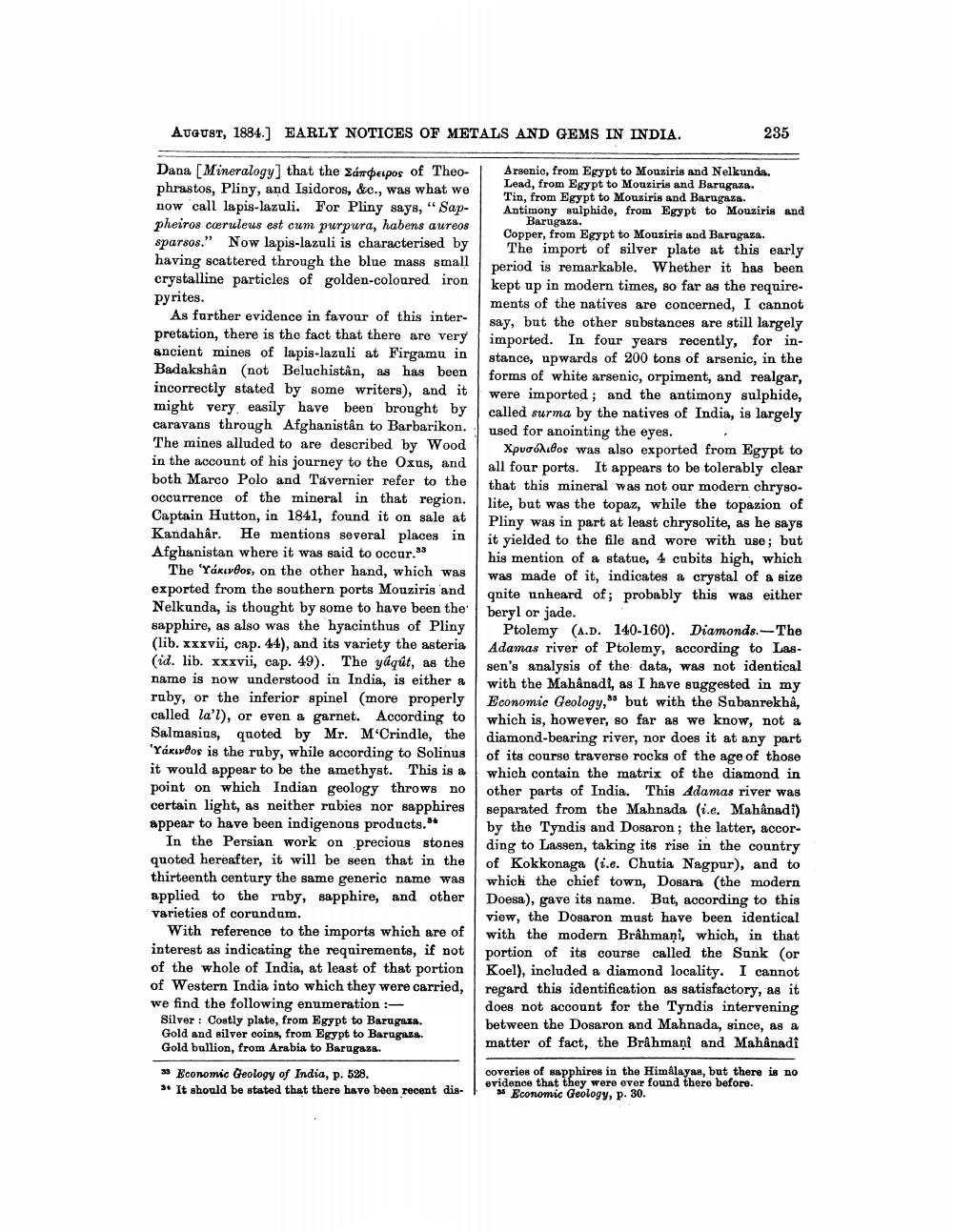________________
AUGUST, 1884.] EARLY NOTICES OF METALS AND GEMS IN INDIA.
235
-
Dana [Mineralogy) that the Sám petpos of Theophrastos, Pliny, and Isidoros, &c., was what we now call lapis-lazuli. For Pliny says, “ Sappheiros cæruleus est cum purpura, habens aureos sparsos." Now lapis-lazuli is characterised by having scattered through the blue mass small crystalline particles of golden-coloured iron Pyrites.
As further evidence in favour of this interpretation, there is the fact that there are very ancient mines of lapis-lazuli at Firgamu in Badakshân (not Beluchistân, as has been incorrectly stated by some writers), and it might very easily have been brought by caravans through Afghanistan to Barbarikon. The mines alluded to are described by Wood in the account of his journey to the Oxus, and both Marco Polo and Tavernier refer to the occurrence of the mineral in that region. Captain Hutton, in 1841, found it on sale at Kandahår. He mentions several places in Afghanistan where it was said to occur.SS
The 'Yakubos, on the other hand, which was exported from the southern ports Mouziris and Nelkunda, is thought by some to have been the sapphire, as also was the hyacinthus of Pliny (lib. xxxvii, cap. 44), and its variety the asteria (id. lib. xxxvii, cap. 49). The yaqut, as the name is now understood in India, is either & ruby, or the inferior spinel (more properly called la'l), or even a garnet. According to Salmasius, quoted by Mr. M'Crindle, the 'Yári@os is the ruby, while according to Solinus it would appear to be the amethyst. This is a point on which Indian geology throws no certain light, as neither rubies nor sapphires appear to have been indigenous products."
In the Persian work on precious stones quoted hereafter, it will be seen that in the thirteenth century the same generic name was applied to the ruby, sapphire, and other varieties of corundum.
With reference to the imports which are of interest as indicating the requirements, if not of the whole of India, at least of that portion of Western India into which they were carried, we find the following enumeration :
Silver: Costly plate, from Egypt to Barugasa. Gold and silver coins, from Egypt to Barugas. Gold bullion, from Arabia to Barugaz. 3 Economic Geology of India, p. 528. 3. It should be stated that there have been recent dia.
Arsenie, from Egypt to Mouziris and Nelkunda. Lead, from Egypt to Mouziris and Barugia. Tin, from Egypt to Mouziris and Baruguts. Antimony sulphide, from Egypt to Mouziris and
Barugaza. Copper, from Egypt to Mouziris and Baragaza.
The import of silver plate at this early period is remarkable. Whether it has been kept up in modern times, so far as the requirements of the natives are concerned, I cannot say, but the other substances are still largely imported. In four years recently, for instance, upwards of 200 tons of arsenic, in the forms of white arsenic, orpiment, and realgar, were imported; and the antimony sulphide, called surma by the natives of India, is largely used for anointing the eyes.
Xpvoólidos was also exported from Egypt to all four ports. It appears to be tolerably clear that this mineral was not our modern chrysolite, but was the topaz, while the topazion of Pliny was in part at least chrysolite, as he says it yielded to the file and wore with use; but his mention of a statue, 4 cubits high, which was made of it, indicates a crystal of a size qnite unheard of; probably this was either beryl or jade.
Ptolemy (A.D. 140-160). Diamonds. --The Adamas river of Ptolemy, according to Lassen's analysis of the data, was not identical with the Mahanadi, as I have suggested in my Economic Geology, as but with the Subanrekha, which is, however, so far as we know, not a diamond-bearing river, nor does it at any part of its course traverse rocks of the age of those which contain the matrix of the diamond in other parts of India. This Adamas river was separated from the Mahnada (ie. Mahanadi) by the Tyndis and Dosaron; the latter, according to Lassen, taking its rise in the country of Kokkonaga (i.e. Chutia Nagpur), and to which the chief town, Dosara (the modern Doesa), gave its name. But, according to this view, the Dosaron must have been identical with the modern Brâhmani, which, in that portion of its course called the Sunk (or Koel), included a diamond locality. I cannot regard this identification as satisfactory, as it does not account for the Tyndis intervening between the Dosaron and Mahnada, since, as a matter of fact, the Brahmani and Mahanadi
coveries of sapphires in the Himalayan, but there is no evidence that they were over found there before.
Economic Geology, p. 30.




